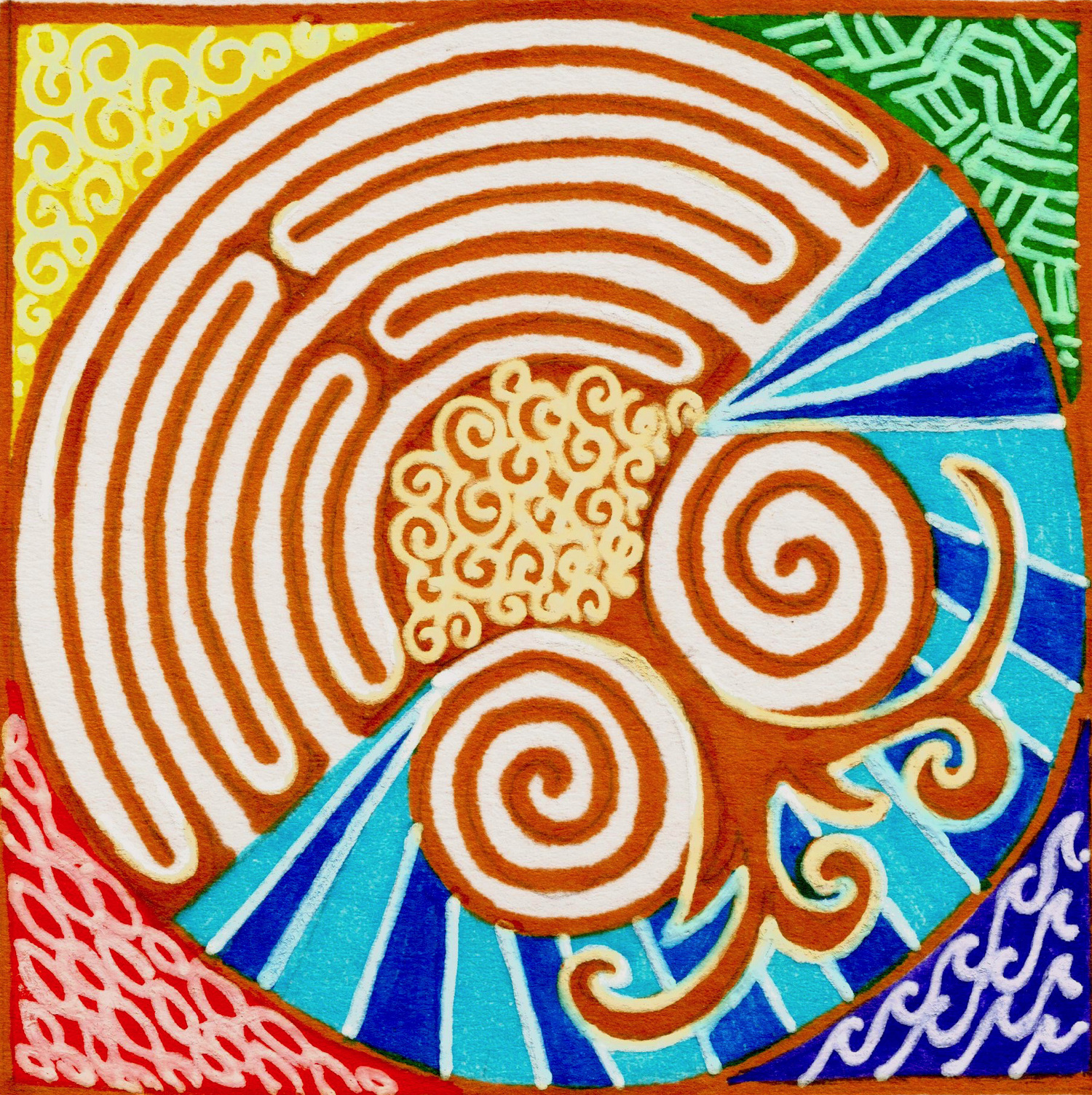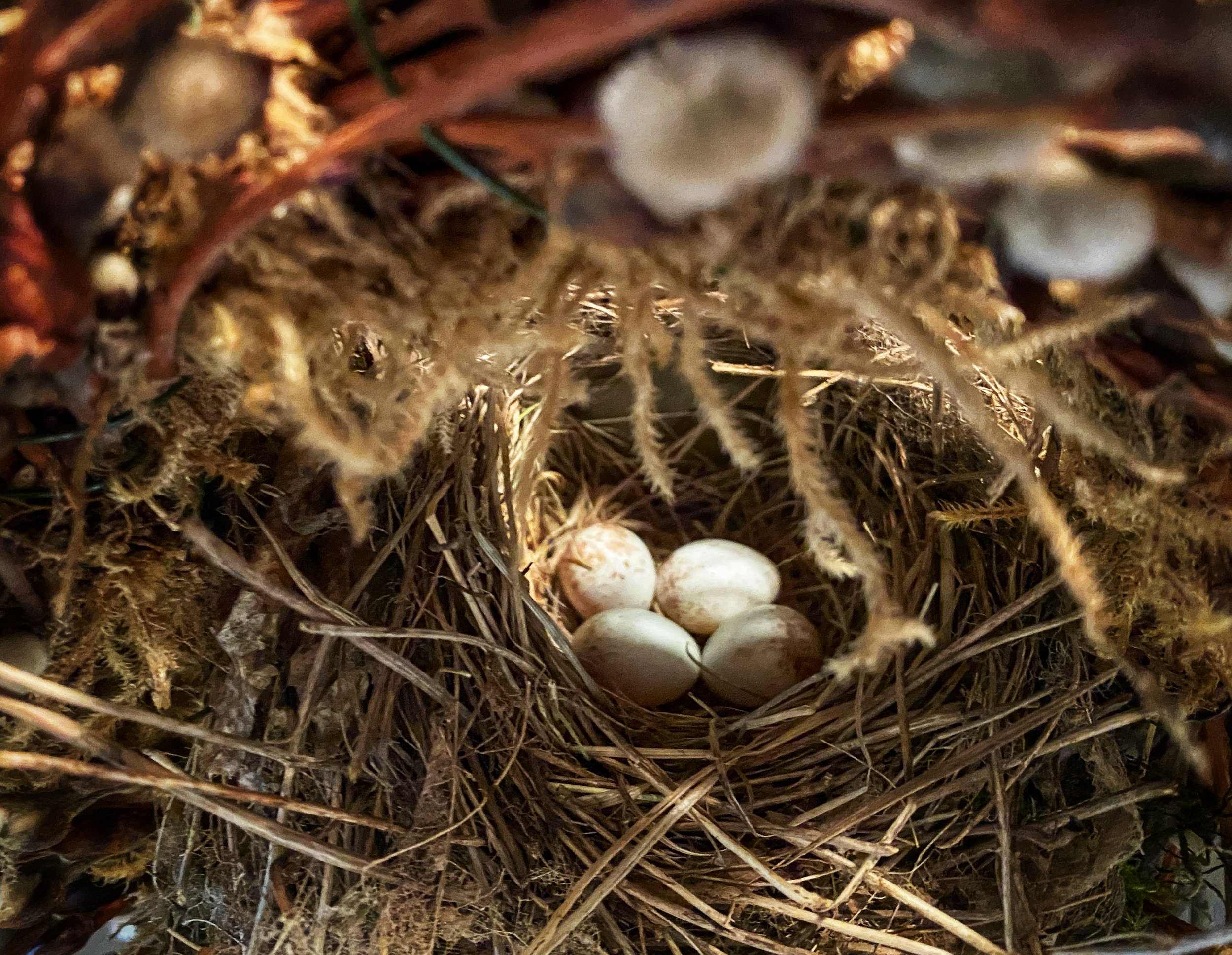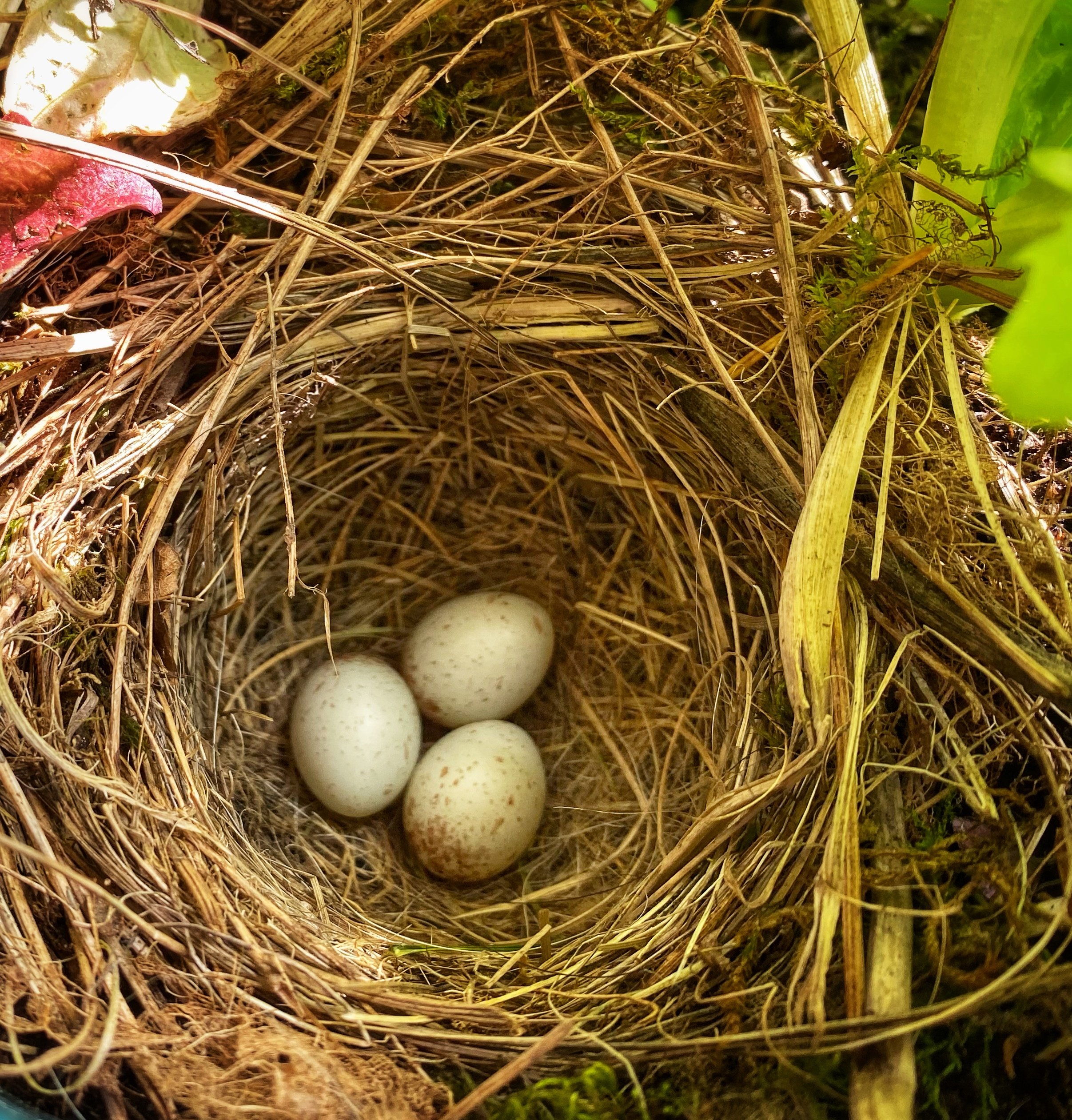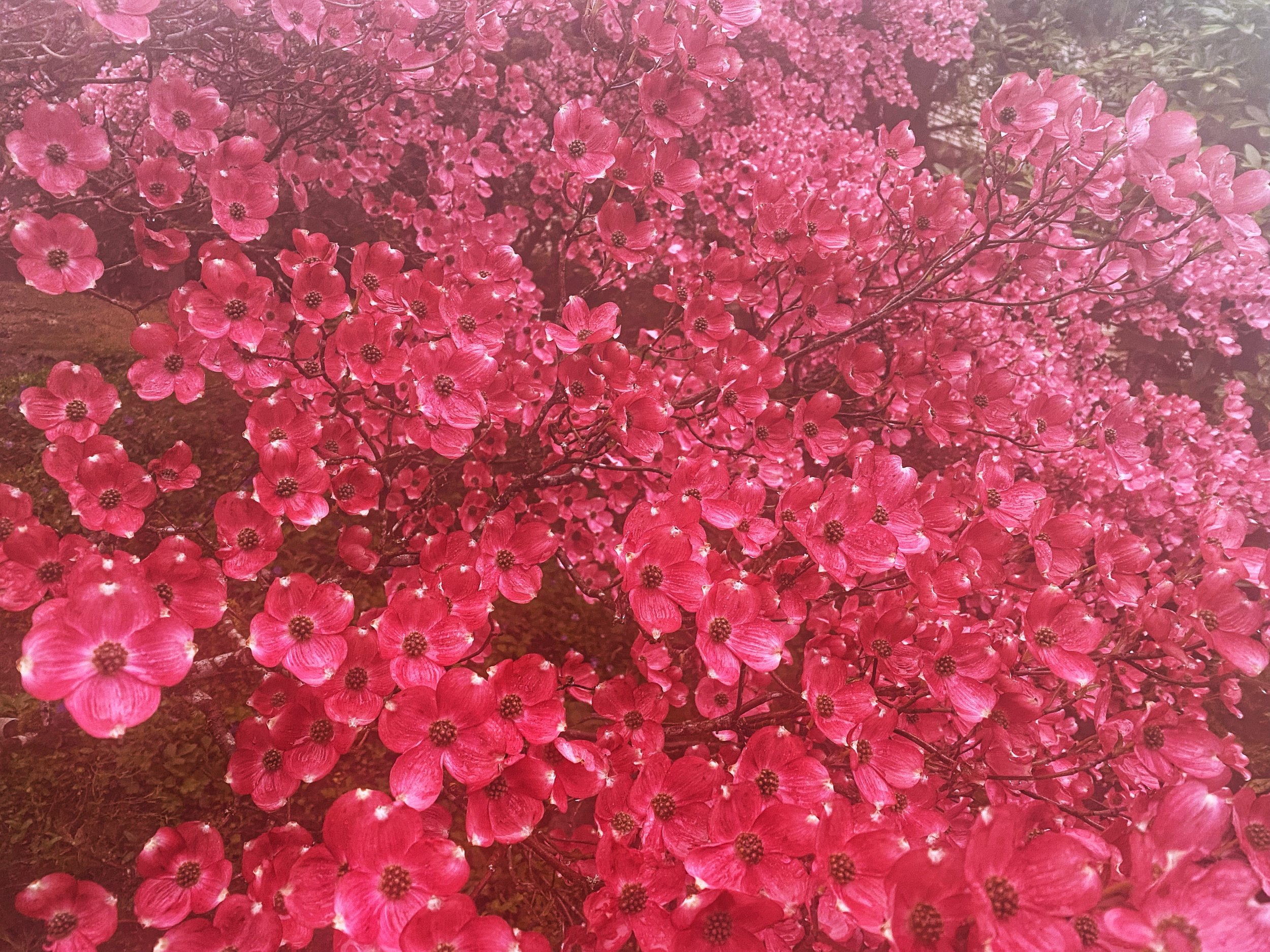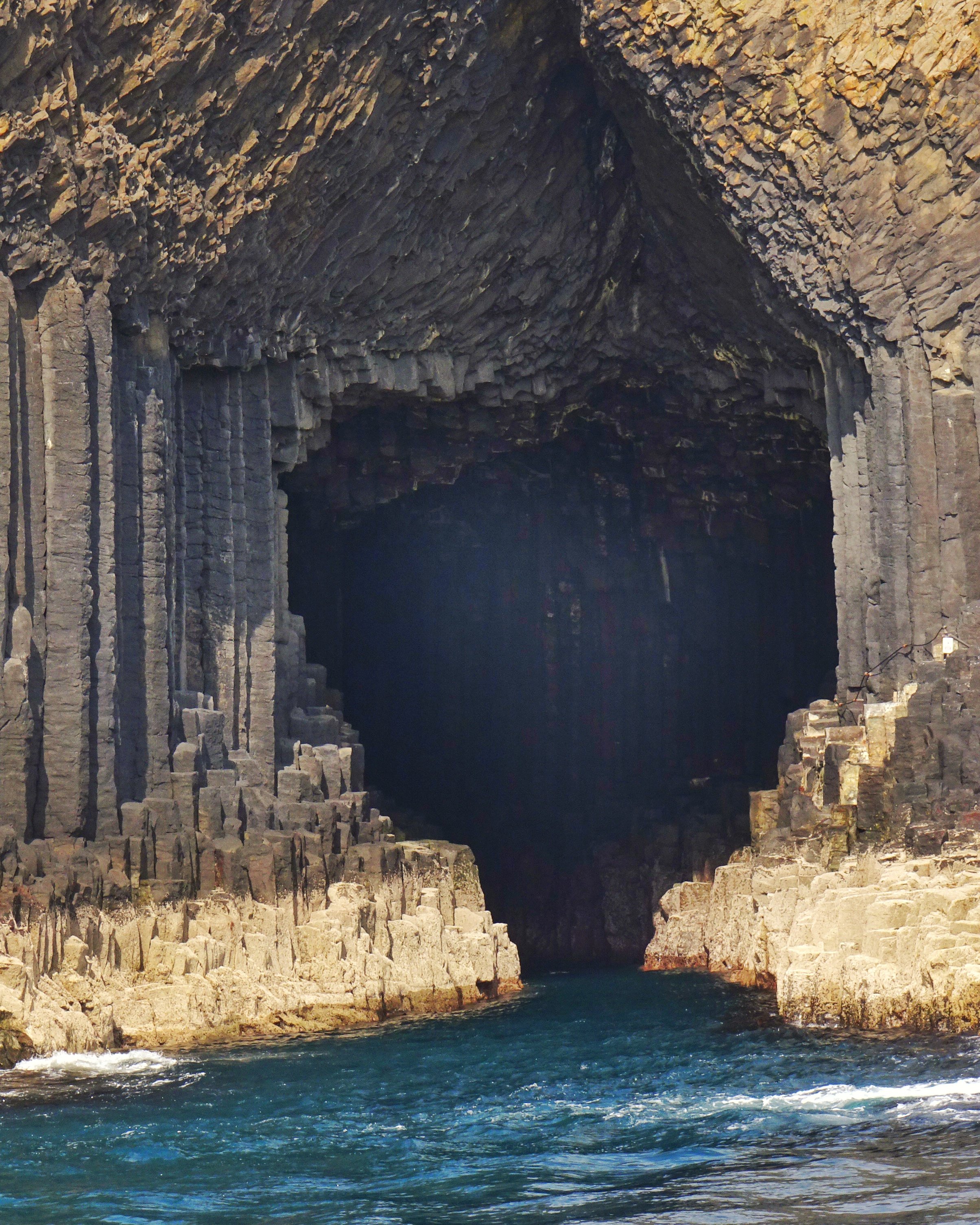Recently laid eggs of Dark-eyes Juncos nestled in a nest on the wreath hanging from my front door. One of the gifts I’ve received this spring season. photo by anne richardson
Protecting the Nest
Wee birds have created three nests outside my apartment. Three! One on the wreath attached to my front door. Two are on the deck in hanging pots. Juncos have taken up residency, voicing annoyance with every coming and going. I tap on the door before exiting, tug slowly on the handle and apologize to the small body complaining on the railing, railing at my disturbance. When I return home, I see a small head poking out of the nest. I wave “hello,” and the mama flies out and sizes me up, assess the situation. Will I try to harm her eggs? What tack should she take? Attack? Opening the door, I slip inside. I want to retrieve my step stool and peek at the eggs, but that seems like an intrusion. They need nurturing. Warmth, not peering. So I leave them be, though I can’t resist snapping a quick photo before she returns.
Creating Welcome
On the afternoon I started writing this post, I noticed another Junco nestled in a back nest. I have a lovely assortment of birds come to sip and splash in the birdbaths, so perhaps they feel welcomed here. Chickadees, wrens, swallows, goldfinches along with the Juncos. Even an occasional Steller’s Jay or crow will stop by. Plus a couple of squirrels who I swear have been digging for the same peanut from my pots all winter long.
Wisdom Watch
There was a gap between the completion of the “wreath nest” and habitation. I thought this was odd. As this wreath made of bent pussy willow branches is not that sturdy, perhaps the birds considered another site and abandoned it. I was wrong of course, bird wisdom or instinct being what it is. Though I haven’t researched it, my guess is, it is takes time for the eggs to form in the mother and in that time she nourishes her own body, then returns to the nest. And now we are waiting for the hatching. Readying for the next generation.
Nest on the back deck. photo by anne richardson
Pandemic Losses:Unsettled Grief
This observing nest building and birds has been a delight this spring. A spring that has been wet and cool (the wettest April on record in my region of the Pacific Northwest, following the driest April last year.) A spring that has “two years ago…” reminders of early COVID days on social media popups including improvised masking and long lines with six-foot spacing markers. A spring that is leading us into a new “phase” of the pandemic…not full-blown pandemic, but not to be taken lightly either, as my abundance of N95’s can attest to. Daily reminders of those who died over the last 24+ months (some from COVID and others from to an inability to access healthcare due to overwhelmed systems) may not be in the headlines, but these loses still weigh heavy. As I write this we passed the official milestone of one-million COVID deaths in the United States; over six-million worldwide. (Here is a lovely Op-Doc, Not Even For A Moment Do Things Stand Still, honoring those who died of COVID that I recommend.) And this ripple in the pond (or is it more tsunami in the ocean) has affected many more lives. This is what it is to live in an unsettled world. To have your perspective altered. It has been a dizzying two years. When has there been time for grieving? To even name the losses you may have experienced, directly and indirectly since the start of the pandemic?
The dogwoods have loved the cool, wet Pacific NW Spring. As I walked on a recent, rainy morning, this beauty called out to me and seemed to represent both our collective desire to reengage “in real life” and the overwhelm of being back out in the world—navigating anew our personal comfort zone alongside community engagement. photo by anne richardson
Grief Listeners
We are in a state of collective grieving and individual grieving. A both/and place. An opportunity to be with each other. You don’t need to be a professional to be with someone who is grieving (and it can be difficult to access an experienced grief expert these days…that overwhelm again.) The gift you can offer is to listen. Create a nest…that safest of spaces for a story to be shared. Silence to be held. Nourish your friend, family member, neighbor with a meal. A kindness. A card that says, “thinking of you.” Know you won’t be perfect, but risk stumbling over words out of bewilderment and then apologizing and learning from it, is better than ignoring the grieving person/people in your life.
And if you are the one grieving. First, be kind and gentle with your heart. You may have been holding your Grief close long before the pandemic…or it may be a new companion. You may feel exhausted and looking for resources may be the last thing you have the energy for. If you have that person in your life who will listen without trying to “fix you,” then wonderful. Ask them for support. Know you are not alone. There are resources on social media, if searching there feels comfortable. I have a few listed in the Grief, End-of-Life, and Bereavement section of my resources page. And please feel free to reach out to me.
Honoring Grief’s Natural Rhythm
I forgot to mention…the “wreath nest,” took three weeks to build. Trial and error. Debris would be scattered on my welcome mat. Bits of moss and fluff. Nothing seemed to “stick.” In the six years I have lived in this place I call home with this wreath on the door through the spring seasons, this is the first time the Juncos have chosen this spot. Perhaps it was a false start? But they persisted. And, literally, yes literally, the day after I thought to take the wreath down the next morning so they could find another spot, the nest was complete. Shows what I know. Perhaps I am reaching, but our Grief journey can be like that. We think we know what is better for someone else. Or we get tired of the messiness. Or. Or. Or. Letting Grief fall into a natural rhythm…your own innate rhythm may be all Grief is asking of you. To listen to your own wisdom. It is there.
And yes, I know there is more to unpack (or “hatch” if we are staying with the metaphor) as I listen to what my Mentor Grief is whispering in my ear about nesting with our losses. Or what you are whispering in my ear. Because a lot of what I learn about loss and journeying with Grief comes from listening to those I work with, stories shared in writing groups, my volunteer work with the Dougy Center, and random encounters even. Thank you for trusting me with your wisdom.
************************************************
Sojourning with Stillness
Posts on “Lessons from the Pandemic” will be on hiatus or dare I say, this is a closing chapter…with perhaps only an epilogue in the future. One can hope, though I don’t believe “it” is done with us yet.
As the pandemic has shifted, so has opportunity to travel. I will once again be returning to my “other homeland.” Three years ago I was “Sojourning with Grief” as I returned my mother’s ashes to the UK and explored labyrinths. This year I am “Sojourning with Stillness” as I return to my roots in the UK, with additional time in Ireland and Chartres Cathedral in France. Most of my time will be spent walking and listening to the land, though I will spend some time with family and friends. I look forward to sharing insights on my blog as I lean into the wisdom of place. What Birds, Rivers, Rocks, Trees, and more has to share with me.
As the time away blesses me, may you also be blessed.
“Heart” of Fingal’s Cave, part of the Isle of Staffa off the coast of Scotland from my 2019 “Sojourning with Grief” journey. photo by anne richardson
As always, be kind and gentle to YOU,
in gratitude,
anne
ps: I will be available by email while I am away (mid-May to mid-July,) so please reach out if you have any questions, comments, or would like to connect.
For Your Reflection
As we enter this shift in the pandemic how are you responding? What is stirring in you? Anxiety? Relief? Fear? Anger? Are you numb? Overwhelmed? What happens if you take time to sit with curiosity and look deeper to see what might be stirring those feelings. What is the story?
What are you noticing about the season of Spring (or Autumn for those in the Southern Hemisphere?) Do you find the energy enlivens you? Are you hesitant to engage? What does hope look like for you these days?
This excerpt from poet David Whyte’s poem, “Winter Grief,” talks of rest:
Let the rest/in this rested /place rest for you./Let the birds sing /and the geese call/and the sky race /from west to east /when you cannot raise /a wing to fly.
Take 7-10 minutes and free-write (don’t think, let your pen keep moving) to one of these suggestions:
1) When do you allow yourself time to rest? Where do you go to find it?
2) Use a line that resonates as a starting point.
3) Describe what deep rest looks like to you?
4) Do any of these lines remind you of your weariness in coping with your grief? Your loss(es?)
As you read back what you wrote, what do you notice?
Who are the people, trees, animals, rivers, etc that can listen to your stories of loss gently without offering solutions? What is it like to be received? Whose stories can you receive and hold gently in the same manner?
Spend time watching the birds in your neighborhood. What do you notice? What memories come up, if any?
What loss has risen to the surface now that wants to be noticed? Can you begin having a conversation with it? How might grieving this loss be honored?
Are you being kind and gentle to YOU? Compassionate? Tender to yourself and others? How does that look as you go about your day?
Opportunities
I was honored to present “A Slow Walk With Loss: Anticipatory Grieving in Dementia Care” to HOPE, Dementia Support at the end of March on anticipatory grief and ambiguous loss in support of those who are journeying with loved ones who have dementia. It was the third time they asked me back to present on this topic and with the wonders of Zoom, it was recorded. My presentations are experiential besides informational, so I hope you take a look. Even if you don’t personally have a connection to someone who has been diagnosed with dementia, you likely have a friend or coworker who is grappling with this disease in some way in their life. A little information may help with understanding and compassion..
Bits & Pieces/Odds & Ends
A friend gave me a great read knowing I was going to go wandering around the UK and Ireland: Wanderers, A History of Women Walking by Kerri Andrews. Starting back in the 1700’s to current it is inspirational and informative. The women that roved the English, Scottish and Welsh countrysides (as far as I have gotten) would walk up to 38 miles A DAY. Consider the clothing they would have been wearing. No fancy rainproof pants and jackets or hiking boots. I best not complain if I get so much as a blister while I’m away! Anyway, if you like non-fiction, history, and enjoy the outdoors, I recommend.
Have you heard about the No Mow May movement? It is a new movement (started in 2019 in, drum roll please…ENGLAND) to help pollinators, which are on the decline in many places. I don’t have a lawn, but I do enjoy the benefits of pollinators: bountiful harvests. Appleton, Wisconsin was one the first communities in the USA to embrace No Mow May on a citywide scale. Do you have a lawn? Are you interested in helping the environment and taking the rest of May off from mowing. Check this out.
Final Thoughts
I downloaded a new-to-me The Wailin’ Jennys CD, 40 Days, (2004) that includes a song that is haunting me: Arlington. Perhaps it is the melancholic feel, or that the lyrics, as I hear them, seem to speak into where we are now…a time of dwelling in the House of Grief, asking, “Where do we go from here?,'“ each of us seeking meaning for this time. Yearning to belong in this unfamiliar space. This unfolding. Our lives forever altered. Let me know what you think. (Oh, and the cover has a labyrinth…so bonus!)
